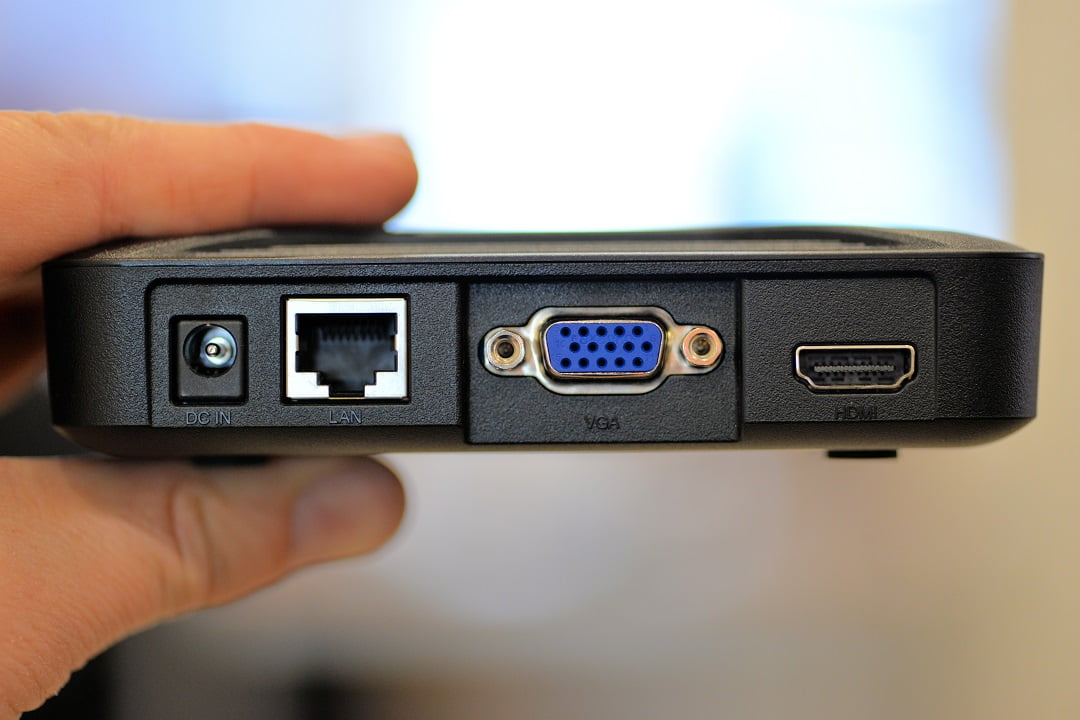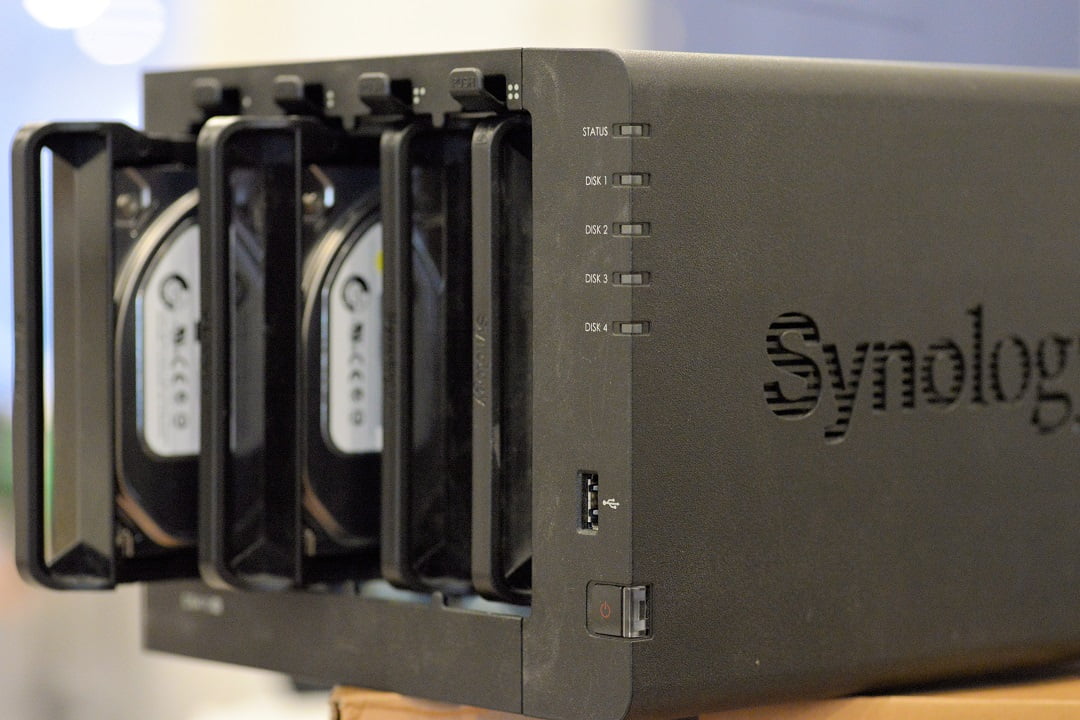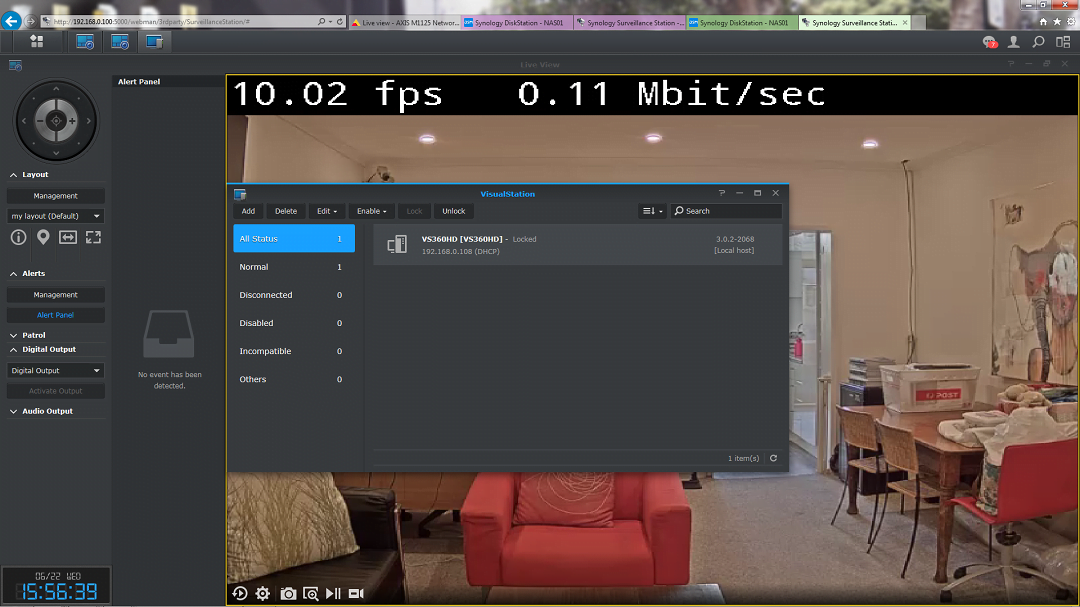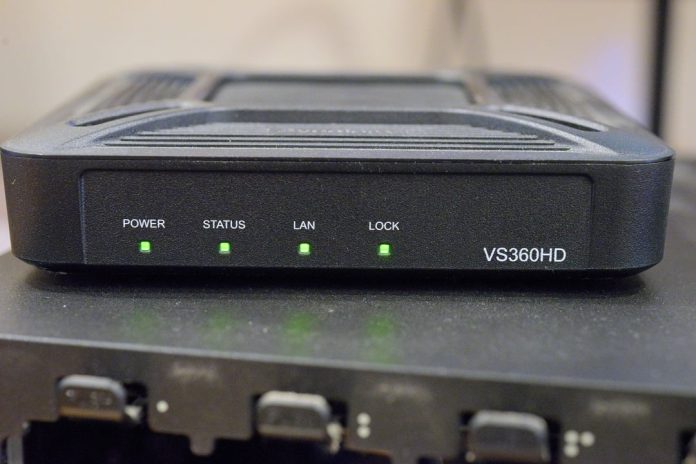Synology’s VS360HD VisualStation is designed to replace the workstation in an IP surveillance solution, providing full management and control of connected cameras from any connected monitor on network fringes. The unit is especially well adapted to supporting retail and reception applications.
SYNOLOGY is well known as a manufacturer of digital storage solutions but the company also makes Surveillance Station software, which turns its network area storage devices into capable video surveillance solutions. Of course, using a NAS to handle some of the tasks of an NVR isn’t always easy and it relies on workstations across the network to handle the grunt work of live monitoring. And this is where our story begins.
In a single sentence, Synology’s nifty little VisualStation VS360HD is designed to support Surveillance Station V7 or higher (we are using 7.2), when paired with a Synology NAS, to give centralised storage with remote management and edge storage at locations where a user may not have space, funds, a suitably clean environment, or the requirement for a fully loaded workstation.
You could use VS360HD in a network room during system programming, you could install it in a guardhouse or reception station where you did not want the cost, risk or distraction of a workstation. You might locate VS360HD in an emergency command centre away from main buildings and infrastructure. Or you could install VS360HD in a dusty and challenging industrial environment – some torturously hot place no workstation could possibly survive.
This unit is silly discreet – it’s only 32mm x 130m by 130m and weighs just 300 grams, so you can hide it anywhere that’s convenient. The VS360HD is a tough puppy. The ribbed fan-less design means greater longevity and excellent resistance to dust – heat resistance is 50C – that’s extreme. Being compact and tough makes the VS360HD very portable – security managers could carry it in pockets, briefcases or emergency packs and power it up anywhere a fully functional workstation might suddenly need to be. All that’s required to create an operator’s workstation is a local monitor (or TV) and a network connection.
Features of the VisualStation VS360HD
Synology’s neat little VS360HD is a rather hard solution to categorise if you approach it from a strictly IP CCTV mindset. It’s not a hub, not a router, not a NAS and not an NVR. Synology describes the unit as a companion. That anthropomorphic descriptor simultaneously does and doesn’t feel quite right from a technical standpoint. Instead, I think the way to best understand this unit is as a discreet, rugged and remote front-end for any Synology NAS running a Surveillance Station 7 back-end.
Typically, with such NAS-based VMS solutions, you need a linked workstation with an appropriate video card to run the show by providing a client interface. What the VS360HD does when linked with a Synology NAS running Surveillance Station 7.0 is replace that PC in your networked CCTV application without cutting back on operational capability. The unit ports to a network on which the NAS resides and supports a local monitor or TV connected directly via HDMI or VGA ports, allowing the viewing of live feeds and recorded images and image streams.

Before we take a test drive, let’s quickly run through the specifications of this solution. The VS360HD outputs video to VGA and HDMI ports at 1080p and there’s an audio input and an audio output. There are 2 USB 2.0 ports and one USB 3.0 (5Gbps) ports, which allow connection of mouse, keyboard, joystick and insertion of thumb drives. There’s also an RJ-45 1GB LAN port. Power is AC via an adaptor and power draw is tiny – about 3.6W on idle and around 4.8W at full load. Operating temperature tolerance is strong at -20 to 50C and there’s a 3-year conditional warranty. There’s a mounting kit that allows the VS360HD to be fitted to VESA-compliant monitors – that means you can tuck the unit up out of sight, making for a tidy and discrete solution.
Video compression formats supported include MJPEG, MPEG-4 and H.264, while audio codecs include PCM, ADPCM, G711, G726, AMR and AAC. Unsurprisingly for a unit of this size, there are performance variables that depend on camera numbers. Total frames per second in H.264 are 360ips at 720p (1270 x 720) for 36 channels. If you go for 1080p image streams (1920 x 1080p) then you get support for 16 cameras. With 3MP (2048 x 1536) you can drive 6 cameras and it drops down to 1 camera at 5MP (2591 x 1944). The parameters are different for less streamlined MJPEG streams, as you’d expect.
The unit employs a system on a chip (SoC) architecture. In general terms, a SoC is an IC that delivers everything from a single processor – and that means everything – digital, analogue, hybrid, wireless – whatever. In this case, the VS360HD SoC functions certainly include the video codec. SoC layouts are lower cost but there’s obviously going to be a performance penalty. Synology doesn’t reveal the specs of the VS360HD processor but it may be similar to the company’s economy DS115j NAS, which features Marvell’s Armada 370 SoC jogging along at a relaxed 800MHz. In the DS115j, this single-core Arm v7 processor offers a cache of 256kb and 256kb of DDR3 system memory – not much to come and go on but enough.
As we know from the EDS14, it’s possible to wring 1.2Ghz out of the Armada 370 but Synology appears happy to spec the SoC in the DS115j for cool running and low current draw. Instructively, the VS360HD runs way cooler than the EDS14 – it’s barely warm to the touch. All other things being equal, lower operating temperature means longer life. The takeaway from this possible spec is that the VS360HD’s modest RAM will see it run slower than Synology’s lower-end NAS units like the 4 or 9-input NVR216, despite its ability to deliver 36 video inputs to a local monitor. That doesn’t signify as a loss of capability for many applications, however. The whole concept of the VS360HD is an inexpensive, discreet, low current device that considerably expands operational access to a Synology surveillance network.
The NAS we are testing the unit with is SEN’s Synology DS710+ which is used to handle typical storage duties at our office. The DS710+ is a couple of year’s old now, but the fact it’s a legacy unit gives our test more of a real world integration feel. The logical pairing with VS360HD is the newer DS415+ but performance with the older NAS is not likely to be an issue in this test. The 710+ features a reasonably snappy 1.67GHz Intel Atom processor paired with 1GB of memory – plenty to handle a single IP camera. The DS710+ includes Surveillance Station 6 support for up to 16 IP cameras and we upgrade this software to the latest version during the VS360HD review process.
Driving the system
Giving me a hand with setup is CSD’s Justin Hallarsis and the time consuming part is handling the upgrade of software to the NAS and VisualStation unit. This shouldn’t be taken to mean the upgrade is hard. The process of working out the existing software in the different units and upgrading it to the latest SS7.2 versions using appropriate formats is just too much for me. The upgrade is a necessary process because our brownfield NAS is running SS6 and I’ve had the VS360HD waiting to test for months and there have been software upgrades since it arrived on my desk.

CSD's Justin Hallarsis handled the software upgrade process and a quick demo prior to my test drive.
In terms of topology, the existing DS710+ is already resident on the network and we simply add the VS360HD to our Netgear switch and then pair it with the NAS. There’s currently an Axis M1125 camera on the network being used for a lens test of Fujinon’s 4.1-9mm varifocal, so we use this camera for the test. As well as being connected to SEN’s Gigabit switch, the VS360HD is also hooked up via HDMI to our standard BENQ 1080p test monitor. All very straightforward. If you’re familiar with it, the process of searching for new cameras is very easy but I flounder around getting lost the first time.
As part of the process, you hop into the NAS to search for cameras, and once this is done, you can access the cameras on the VS360HD. As well as offering excellent networking capability for newbies, Axis is a Synology partner so it’s all too easy. And making our setup simpler, SS7.2 has Auto-Layout, which allows Live View to automatically adjust to the number of video streams displayed. We only have the one camera, so things stay simple. For multi-server deployments with hundreds of cameras, Live View automatically adjusts to best configuration to handle the number of cameras being displayed.
When connected with I/O modules, Surveillance Station can serve as the central hub of various automation devices such as LED lights, electromagnetic locks, motion detectors, and more. Meanwhile, e-Maps allow operators to quickly identify a device’s location on the map when it sends an alert. There are different icons for IP cameras, fisheye cameras, I/O modules and door controllers. Further, icon sizes can be adjusted on e-Map and device names can be hidden. We don’t have I/O modules connected and don’t use eMaps for this basic application but it’s nice to know the functionality is there.
When you open the VSD360HD – I just select the HDMI input and click go – you’re immediately at Live View, which is right where you want to be. The interface of VS360HD is typical Synology – it’s pared back and very intuitive – there’s nothing complicated going on here (server-based Synology CMS is available for users with more complicated solutions). And with variables like camera settings handled via camera browser before or after addition to Live View, there’s no need for multiple levels of complication.

Here's Synology's DS415+, which is the ideal pairing for the VS360HD. We used our office DS710 NAS – it worked great.
Once the VS360HD is paired with our Synology NAS now running Surveillance Station 7.2, it becomes a solution for monitoring live feeds and viewing recordings, as well as taking snapshots and steering camera views. The way recording works is that video footage is stored on the NAS, while screenshots and stills can be archived to an external USB drive. You can employ a mouse, a keyboard or a joystick to operate cameras with PTZ control and there’s very easy digital zoom. You just place the cursor on the tile you want to zoom in or out of and roll the mouse wheel.
With SS7.2, there’s a command line at the top left with Live View, Timeline, Recording and Log options and you simply click on the heading and pop out at the functionality. Live View is what you’d expect – you can select the display layout you want – 4-screen or full frame, as well as driving digital and audio outputs, and undertake patrols. There’s a slider for digital zoom as well as audio volume. Timeline is simple, too. You select one of the connected cameras and the related footage can be found by pulling a vertical slider. Together, Live View, Timeline and the Recording allow browsing and export or video clips and snapshots via the USB 3.0 port.
When you get into recordings, a list of events comes up with camera name and date and you just click to action the recording player. Hopping in and out of this list I can see once again that Axis Zipstream is a very skinny compression format, even at the least compressive setting, and that the M1125 and the Fujinon 4.1-9mm varifocal are making short work of the wee hours of the morning, staying in colour very happily. I note that wherever you are in the system – live view or viewing recordings on the player – it’s always possible to grab a snapshot.

It's a tidy management system – nice WDR performance from the Axis M1125 here, too.
Performance through VisualStation is good – it’s slightly softer than the images dished up by the Dell 9020 running Axis camera browser and there’s slightly more latency, too. I get less than 200th of a second of latency via the Axis browser/Dell combo and it’s more like 400ths of a second through the VS360HD – this may relate to the integrated video codec in the SoC. The slight increase in softness in the display image impacts on digital zoom but given the task of this unit is to extend management and control of surveillance cameras to network fringes, that’s a price many users are going to decide is worth paying.
With Auto-Layout taking care of setup, you just pull a camera from the 4-camera list to one of the quad screen’s tiles. From there you double click to full screen, double click to split screen, and mouse roll to zoom in and out. Along with driving PTZs through the digital PTZ control, something else it’s possible to do is grab particular camera angles and save them as a group to form a Patrol cycle or alternatively, program in presets. Optimized Live View layouts are fully customizable with a quick drag-and-drop from the camera list – all very simple. And while I always prefer snapshot to be accessed via a right click, I find it easy enough to find the camera icon snapshot bottom left of the viewing screen that appears whenever you twitch the mouse then disappears a few moments later.

Management is very simple with plenty of automation. Note the things Axis Zipstream is doing to bitrate at 10fps and 1080p – just ridiculous.
Synology’s Surveillance Station 7.2 is different from Surveillance Station 6, which once you burrowed into it was quite traditional in nature. SS7.2 has more functionality but it’s delivered in a simplified way, with the use of setup and configuration automation. It’s likely this change allows the new interface to better meet the needs of SME customers who may not be familiar with traditional VMS interfaces. There certainly are new features, including QuickConnect and HTTPs support, making for quick access to remote servers with no need to fuss over network config or dynamic IP addresses.
Because SS7.2 is integrated to CMS, you can also bind your recording servers to the host server without network knowledge. To undertake the process, you just enter your QuickConnect ID to establish connection – meanwhile, HTTPs support means Internet comms remain private and secure. There’s also a new notification system that combines similar notifications so as to streamline alerts. And SS7.2 has an adjustable keyframe interval – less time between key frames increases stream stability and quality, while increasing the interval reduces bandwidth consumption. It’s a nice piece of control to have.
Synology’s VS360HD is an interesting addition to the Synology lineup. Once you get your head around the VS360HD, it suddenly becomes clear this rugged little device is capable of considerably enhancing Synology’s NAS-based surveillance solutions. From an operational perspective, the VS360HD adds value not by delivering epic levels of raw performance but by quietly carrying core system functionality out of the control room and deep into hostile territory.
By John Adams
Features of Synology VS360HD include:
* Live View/Recording Playback
* Snapshot Support
* eMap Support
* PTZ Control/Patrol
* Log Viewer
* Compact, fanless and silent
* Industrial-level thermal endurance
* 1 Gigabit ports, 1 USB 3.0 and 2 USB 2.0
* Synology Surveillance Station 7.2
* Works with thousands of IP cameras.











